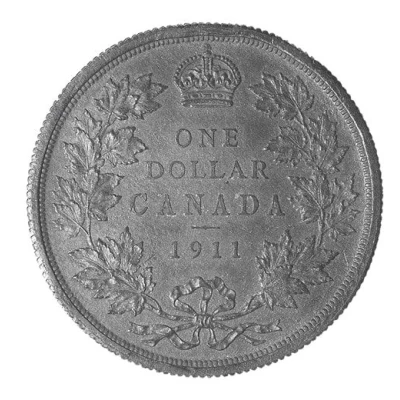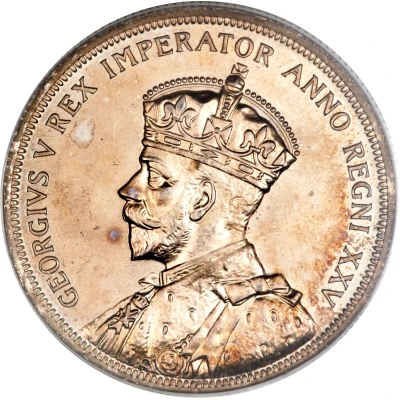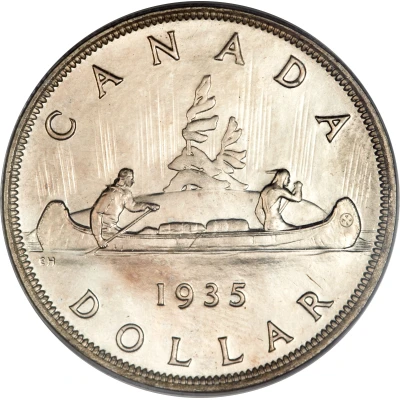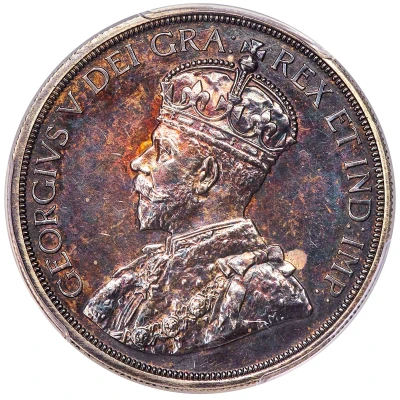
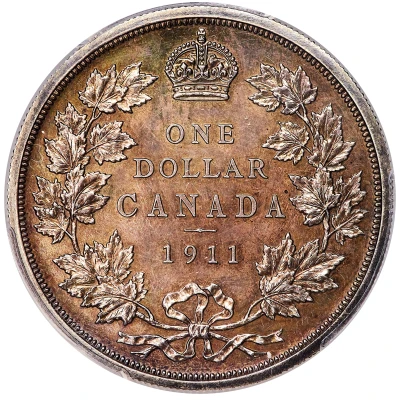

© Heritage Auctions
1 Dollar - George V Silver pattern
1911 year| Silver (.925) | 23.3286 g | - |
| Issuer | Canada |
|---|---|
| King | George V (1910-1936) |
| Type | Pattern |
| Year | 1911 |
| Value | 1 Dollar (1 CAD) |
| Currency | Dollar (1858-date) |
| Composition | Silver (.925) |
| Weight | 23.3286 g |
| Shape | Round |
| Technique | Milled |
| Orientation | Medal alignment ↑↑ |
| Demonetized | Yes |
| Updated | 2024-10-04 |
| Numista | N#181847 |
|---|---|
| Rarity index | 94% |
Reverse
Centered crown at top with the iconic maple wreath surrounding the legend
Script: Latin
Lettering:
ONE
DOLLAR
CANADA
1911
Engraver: W.J. Blakemore
Edge
Reeded
Comment
The 1911 Dollar is considered the greatest, and most storied rarity in all of Canadian numismatics.If the 1921 Half Dollar is considered the "King of Canadian Coins," then it follows that the 1911 Dollar reigns as, "The Emperor of Canadian Numismatics." The story begins with the Canadian Currency Act of 1910, which authorized the striking of a Canadian Silver Dollar in .925 silver with a weight of 360 grains. To facilitate the minting process, a coinage press was obtained from England to specifically strike Dollar-sized coins, and the Royal Mint in London prepared dies to strike two Specimens in silver and one in lead--proposed patterns for a future design. Additionally, cases for the Specimen sets of the first Canadian coinage of George V were produced with a position specifically designated for a Dollar coin. Despite all this, and for reasons unknown, the Canadian government authorities decided against issuing business strike Silver Dollars at this time.
Interestingly, no other first-year George V coin has DEI GRA (for Dei Gratia, or By the Grace of God) in the legend. All other 1911 coinage is referred to as "Godless" because of the omission.
This 1911 silver Dollar is considered a pattern since it was a proposed coin with no business strikes ever having been produced. The two known Pattern Dollars, as well as the lead striking, were struck in London before the dies were sent to Canada. Major Sheldon S. Carroll, Chief Curator of the National Collection at the Bank of Canada stated, "When consideration was being given to issuing a Dollar coin in 1911, dies were prepared (in London) and trial strikes were made. Mint records do not tell us how many such strikes were produced." Until November 19, 1977, the only two known trial strikes were in silver. The lead striking was discovered shortly thereafter on November 20, 1977. It was sent to the Department of Finance in Ottawa for examination and it remained there in a brown paper parcel in the East Block of the Parliament Buildings for more than 65 years. No examples of the 1911 Dollar were known until 1960 when the noted London coin dealer B.A. Seaby obtained this coin from "an undisclosed source," but word quickly spread that the coin had been purchased from the family of Sir William Grey Ellison-Macartney who was the Mint Master at the time the coins were struck. Seaby later discovered the second silver example at the Royal Mint Museum in London-which is the coin on permanent loan to the National Currency Collection in Ottawa.
Two known pieces, one in the National Currency Collection, another in a private collection.
Interesting fact
The Pattern 1 Dollar - George V (Silver pattern) 1911 from Canada is a rare and unique coin, with only 500 pieces minted. It was designed by Sir Edgar Bertram MacKennal, a renowned British sculptor and medallist, and features a portrait of King George V on the obverse side, while the reverse side depicts a maple leaf, a common symbol of Canada. The coin's silver composition and relatively low mintage make it a highly sought-after collector's item among numismatists.
Price
| Date | Mintage | VG | F | VF | XF | AU | UNC |
|---|---|---|---|---|---|---|---|
| 1911 | 2 | - | - | - | - | - | - |
Values in the table are based on evaluations by sales realized on Internet platforms. They serve as an indication only for 1 Dollar - George V (Silver pattern) 1911 coin.

